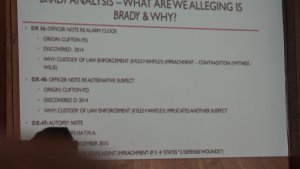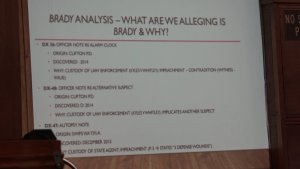In 1985 a Clifton, Texas High School Principal, Joe Bryan, was attending a conference in Austin with several other principals from around the state. At 9:15 p.m. on October 14, 1985, he spoke to his wife Mickey, also a school teacher in Clifton. Later that evening his wife was discovered shot to death in their Clifton home. The next morning the Superintendent drove to Austin to deliver the news. Shortly after investigators charged Bryan with the death of his wife. Bryan, who had problems driving at night was said to have driven in his Mercury from Austin to Clifton, in a heavy rainstorm, killed his wife, changed clothes in the bedroom and returned to Austin having breakfast with colleagues at 8 a.m. Texas Rangers contacted Harker Heights, Texas, Investigator Robert Thorman who had just completed a 40-hour course on blood stain analysis. This was his first major case using the analysis. Thorman testified in the 1986 trial and again in 1989 that a flashlight found in the truck of Joe Bryans Mercury 4-days later by the victim’s brother had small specks of blood spatter on it. This type of pattern would be consistent with a close-range shooting. He testified he believed the killer had had the flashlight in one hand and shot Mickey Bryan with the other. She had been shot three times in the head and once in the stomach with a .357-magnum pistol. The master bedroom was covered in blood. An expert in 1986 testified the blood on the flashlight was “O” Positive. Somehow, he was able to persuade both juries’ to believe this was important because the victim had the same type of blood, along with several million other people. Bryan was sentenced to 99-years in the Texas Department of Criminal Justice in Bosque County in April of 1986. Then again July of 1989 he was convicted again after the 10th Court of Appeals in Waco sent the case back for a retrial and a change of venue to Comanche County. The opinion of the same court on the second trial they affirmed and said the case was based on circumstantial evidence. The blood was the biggest part of gaining the conviction by prosecutors.
Just 4-months prior to Bryan’s wife’s murder, Judy Whitley, a 17-year-old Clifton High School student vanished one night. Her body was found nude the next day in a wooded area across town. Many teachers who worked with Bryan also felt he was innocent. Many pointed a finger at Clifton Police Officer Dennis Dunlap. Dunlap, as many said seemed strange. He would park outside the school as the students were released and ask teachers if they wanted him to follow them home to make sure they made it safely. He made advances to several in a local washeteria. He then left the Clifton Police Department after the incident and went to Dallas. After several years he went to Rosenburg, Texas to work for a concrete company. In 1996, the son of the owner of the local Clifton Newspaper, Leon Smith, who had been a student of Bryan’s wife and friends with Judy Whitley decided to look at the murder again. He traveled to Rosenburg on a Friday to interview Dunlap, he brought up the Bryan case and the Whitley case. The following Monday Dunlap committed suicide by hanging. Following that the Clifton Police Chief declared Dunlap as being responsible for the student’s death after he learned that Dunlap confided in other officers he worked with of details that nobody, but the killer would have known. He also learned of Dunlap’s long history of violence on women and a comment Dunlap made to a fellow officer that he was glad they didn’t find a roll of tape in the trunk, the same type of tape used on the young girl. Dunlap’s ex-wife told Texas Rangers after that Dunlap bragged about having an affair with Mickey Bryan and was with her the night she was killed. He told his ex-wife that Mickey Bryan, told Dunlap that night she was separated from her husband was planning to reconcile and wanted to break it off with Dunlap. The issue there was none of the friends or co-workers of Bryan knew they had ever been separated.
The entire case caught the attention of Pam Colloff, a writer for the New York Times Magazine. She became so intrigued that she took a class on Blood Spatter. The same type of class taken years earlier by Thorman. She learned as much as she could on Blood Spatter.
Now steps in Montgomery County Sheriff’s Department Crime Scene Analyst Celestina Rossi. A Deputy with the Sheriff’s Office October 4, 1997. Being in the Crime Lab the past 6-years Rossi became quite intrigued by Blood Spatter and the science behind it. In November of last year, she was at the Sheriff’s Office watching the Texas Forensic Science Commission’s quarterly meeting on live stream. The Commission, appointed by the Governor is tasked with investigating complaints on the misuse of forensic science in court testimony. Being discussed was the complaints of two cases, one in Houston and the Joe Bryan case in Comanche County in which they believed the blood spatter testimony was false. The Commission then questioned what the criteria was for someone to go into a courtroom and testify to blood splatter analysis. It appeared that the wasn’t enough knowledge within the Commission on how to set this criteria. Rossi, who some now call the “Abby” ( a fictional character Abby Sciuto who is CBS Television series NCIS forensic genius) of Montgomery County, has become an expert in blood spatter analysis over the past 6-years she has been assigned to the Crime Lab at the Sheriff’s Office. Rossi and former Crime Lab Analyst Christine Ramirez, who is now with Texas A&M Extension Service now teach a 40-hour on blood spatter. Rossi then contacted the commission and asked to meet with them and explain what blood spatter analysis is and how it is being taught in Texas. In January she testified in front of the Commission. Then in February, they started issuing criteria in which they stated in order to render expert opinions, a lab would have to be accredited. In whatever field the opinion was rendered in. This included blood spatter, crime scene reconstruction, shooting reconstruction. Rossi then started attending regular meetings and offering input when needed. In May the Commission requested Rossi to look at the Houston case and the Joe Boyd case. She recused herself from the Houston case but approached Sheriff Rand Henderson with the request by the commission as Rossi said it would have to be his decision to allow her to become involved. Sheriff Henderson, who has always worked well with other agencies in the fight for crime and justice graciously granted the commissions request. In August Rossi argued in the courtroom in Comanche that the scientific evidence provided by Investigator Robert Thorman in trial was “junk science”. Thorman, now retired and 80-years old living just outside Austin hearing this and reading the testimony in the case and Deputy Rossi’s testimony filed an affidavit with the court last Thursday.
In the affidavit, he wrote: I conducted a review of the August 20, 2018, testimony pertaining to my bloodstain analysis of a homicide scene (the Mickey Bryan case). I conducted on 10-15-1985. The testimony indicated that current experts in my field believed my analysis was incorrect. They stated my techniques and methodology were wrong, therefore my conclusions were wrong. As a result of this, and the fact that this was my first major case I worked utilizing bloodstain analysis. I will agree that some of the techniques and methodology were incorrect. Therefore, some of my testimony was not correct.
I do want to add that in my basic report I did state on more than one occasion that, based on the condition of the crime scene, that all of my measurements could not be considered accurate. I also stated that due to the condition of the scene, my results could not be considered accurate and that all the results only reflect the possibilities of what occurred. I want it to be known that in no way did I le in my report or testimony, as I was doing what I thought was correct as a result of my training at the time.
On Monday, September 17, a hearing was held again in Comanche County, Judge Shaver presiding. Present was Mr. Bryan, dressed in black and white striped jail garb. He sat quietly against the wall as his attorney Skip Reeves, and Jessica Freud prepared for the hearing. Reeves has been Bryan’s attorney for many years, Freud was a law student at Baylor and was interning for Reeves when she started helping on the case. That was 5-years ago, and she has not let up yet in the attempt to free Joe Bryan. Seated in the courtroom were friends and family all wearing, “Justice for Joe” t-shirts. Hopes for Monday’s hearing were that after all that had happened the Judge would at least set a bond to free Joe Bryan from his prison cell until another trial or another court action. Bryan has been eligible for parole 4-times now, is said to be a model prisoner, yet Texas Board of Pardons and Parole refused to grant him parole. Some close friends feel It is because he has not admitted to killing his wife. Three witnesses were called to the stand. The first was Brent Watson, a DNA analyst with DPS Crime Lab. Watson told the court that he tested six minute stains on the flashlight. Five of those stains came back negative for the presence of blood. The sixth stain tested positive, but whose blood it was could not be determined. He also testified the partial DNA profile from the flashlight switch ruled out both Joe and Mickey Bryan as contributors. He also testified that Mickey Boyd’s blood or DNA was not at all present on the flashlight. Next Deputy Rossi was called back to the stand for additional blood spatter testimony. It looked good for Joe Bryan at the end of the hearing, the flashlight basically the only real piece of evidence used was totally discredited as being involved. The current Bosque County District Attorney Adam Sibley who was only close to 5-years-old when the murder happened argued the flashlight was at the scene and fragments on the lens possessed the same characteristics as shell fragments. Jessica Freud told the court that there is nothing left of the States case. Freud said a new trial should be devoid of faulty bloodstain-pattern analysis and irrelevant evidence, like the underwear; it should not be tried by a special prosecutor paid for by the victim’s family, and it should “permit a full and fair presentation of all of the exculpatory evidence to a jury. If they’re going to retry him, make them do it the right way. They’ve never done it the right way.” She then told Judge Shaver the Joe was in Austin, he never left, he is innocent and has always been innocent. The Judge then gave the State and defense until November 9 to present written conclusions on Monday’s hearing. Shaver then recommends to the Texas Court of Criminal Appeals as to if a new trial should be granted. Joe Bryan, who will turn 78 on Friday and is in poor health was then escorted out of the courtroom and transported back to Huntsville. According to TDCJ his projected release date for his sentence will be in May of 2025. Joe Bryan’s case has not been the only flawed case in Texas, Clarence Brandley, sentenced to death row for the 1981 killing of a Conroe High athlete. He was freed in 1990. Anthony Graves was the 138th exonerated death row inmate in the United States. In that case, the prosecutor was disbarred. Graves was accused of killing a family of 6 in Somerville in 1992. He was in prison for 18-years. He was also awarded $1.4 million dollars for his time his freedom was removed. If faulty blood spatter testimony is given in the cases over the years it makes one wonder how many more could be innocent.
DEPUTY ROSSI TALKS ABOUT HER ASSIGNMENT
STATEMENT OF EX-WIFE OF FORMER CLIFTON POLICE OFFICER WHO KILLED TEEN
FULL TESTIMONY


































